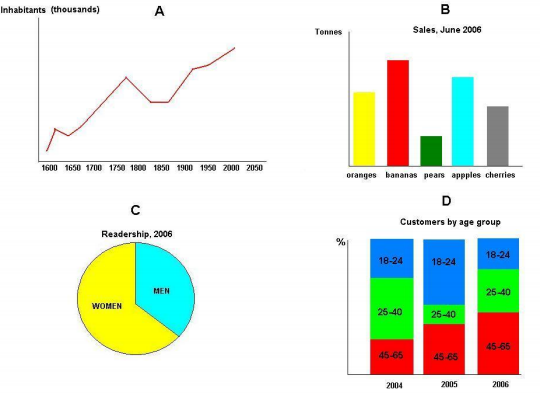IELTS diagram writing is to simply write about what you see using specific rules and vocabulary.
There are six types: line graph, pie chart, table, column graph, bar chart and diagram (flow and map).
 The trick is to point out the major differences and similarities of the diagrams, using case-specific vocabulary to describe these trends. No personal input is necessary. Simply state what you see.
The trick is to point out the major differences and similarities of the diagrams, using case-specific vocabulary to describe these trends. No personal input is necessary. Simply state what you see.
Use a few minutes (2-3) to map the high and low points along with the similarities and differences. Use linear or other visual aids to prepare at this stage.
I. INTRODUCTION
- The rule is simple. Rephrase, or re-write the question, adding ALL (if possible) details from the chart(s).
- A minimal of three to five words must be re-phrased. Keep it short and precise.
- Try to use the passive present tense for the introduction. If you find it too difficult, it MUST be in the present tense.
II. SUMMARRY OF THREE GOLDEN RULES
- Paraphrase the question (re-write) with complete (if possible) details from diagrams
- Use synonyms, paraphrasing as much as possible
- Use present passive tense for a formal approach (if not feasible, present tense)
III. OVERVIEW
Simply write about the major trends and or similarities/ differences apparent in the diagram(s). This can be short but sometimes more precise details should be given. If possible use 2-3 sentences.
DO NOT ADD extra information/opinions/ data. Please use complex grammar structures.
IV. BODY (usually 2 for figures/data)
Using case specific-vocabulary, relate what is shown or described in the diagram(s). When faced with two/three/four diagrams, you may write about each diagram/ or group similar ones together and use separate paragraphs for each one.
ALWAYS WRITE ABOUT THE DIFFERENCES AND SIMILARITIES. You must point out these facts otherwise you will lose points. The verb tenses used will be the ones presented in the diagrams. Complex grammar structures are expected here.
REVIEW: Introduction, Overview, and Body (1-2-3) are necessary. Write about the major details.
- Tip: think of starting with task 2 as it is worth twice as much as task 1. If you have only 10-15 minutes left for task 1, make sure you have all of the structure there (introduction, overview and body paragraphs). If you miss some data, it will cost you some points but overall not too bad for a total score.
- Decimals/millions are written out in numbers, ei: 1 to 1.2 million/
- As this is a formal paper, no abbreviations/ contractions; example: not “it’s”, but” it is”.





















